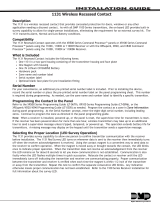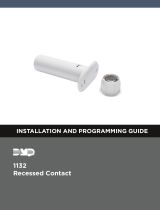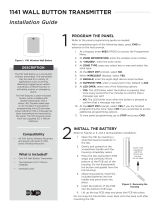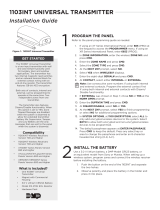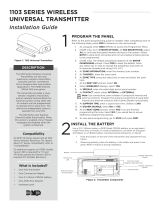Page is loading ...

1131 WIRELESS RECESSED
CONTACT
Installation Guide
DESCRIPTION
The 1131is a wireless recessed
contact that provides concealed
protection for doors, windows,
or any other application needing
a discreet contact. As with all
DMP 1100Series transmitters,
the onboard LED provides
built‑in survey capability to allow
for single‑person installations,
eliminating the requirement
for an external survey kit. The
1131transmits Normal, Alarm, and
Low Battery conditions.
Compatibility
• All 1100Series Wireless Receivers
and panels with built‑in 1100
Series Wireless Receivers
What is Included?
• One 1131Transmitter
• One 1131MAG‑W Magnet
• One 3V Lithium
CR12600Battery
1PROGRAM THE PANEL
Refer to the panel programming guide as needed. After completing
each of the following steps, press CMD to advance to the next
prompt.
1. At a keypad, enter 6653 (PROG) to access the Programmer
Menu.
2. At ZONE INFORMATION, enter the wireless zone number.
3. At *UNUSED*, enter the zone name.
4. At ZONE TYPE, press any select key or area and select the
zone type.
5. At AREA NO, enter the area number.
6. At the NEXT ZN? prompt, select NO.
7. When WIRELESS? displays, select YES.
8. At SERIAL#, enter the eight‑digit device serial number.
9. At SUPRVSN TIME, enter a supervision time. Default is 240.
10. At the NEXT ZN? prompt, select YES if you are finished
programming the zone. Select NO if you would like to access
additional programming options.
11. To save panel programming, go to STOP and press CMD.
Figure 1: 1131 Recessed Contact
INSTALL THE BATTERY
2Use only 3.0V lithium batteries, such as the Model CR12600.
1. Insert a small screwdriver in the hole at the bottom of the
housing tube to push out the battery tray and PCB.
2. Place the battery back into the battery tray with the
negative end of the battery facing the transmitter PCB.
3. Slide the battery tray and PCB into the housing tube as
required for desired travel distance. Refer to Figure 2.
Travel Distance
Depending on PCB orientation, the distance that the door can
travel before a fault is indicated can be increased or decreased.
For areas where wood doors expand and contract seasonally, it
may be helpful to increase travel distance.
Note: The travel distance of sliding doors is 3/4“ regardless of
the reed switch orientation.
3/4Inch Travel Distance—Install the transmitter with the reed
switch on the top side of the PCB to allow a longer (3/4”) distance
of travel.
3/8Inch Travel Distance—Install the transmitter with the reed
switch on the bottom side of the PCB to allow a shorter (3/8”)
distance of travel.

2 1131 INSTALLATION GUIDE | DIGITAL MONITORING PRODUCTS
MOUNT THE TRANSMITTER AND CONTACT
1. To install the transmitter, use a 5/8” spade drill bit and drill a hole at least 43/4” deep in the frame at
the desired location.
Caution: Avoid drilling in areas where electrical wiring runs through the wall.
2. Insert the transmitter housing into the hole until the cap is flush with the door jamb. Refer to Figure 3.
3. To install the magnet, use a 5/8” spade drill bit, drill a hole at least 3/4” deep in the frame at the desired
location.
4. Insert the magnet into the hole and press it into place.
4
3The 1131 provides a Survey LED capability to allow one person to confirm communication with the wireless
receiver or panel while the cover is removed.
1. Move the magnet within 1/2 inch of the contact or pull it away from the contact to send data to the
receiver.
Confirmed: If communication is confirmed, the LED blinks once, immediately on and immediately o.
Repeat this test to confirm five separate consecutive LED blinks. Any indication otherwise means
proper communication has not been established. Repeat this test to confirm five separate
consecutive LED blinks. Any indication otherwise means proper communication has not been
established.
Faulty: If communication is faulty, the LED remains on for about 8 seconds or flashes multiple times
in quick succession. Relocate the contact or receiver until the LED confirms clear communication.
For contact operation, the transmitter and magnet assembly should have no more than 1/2” between the
housings after installation. When mounting on metal (ferrous) surfaces, this distance is slightly less. For door
installations, it is recommended the transmitter be mounted in the door frame and the magnet assembly be
mounted in the door. If the transmitter is installed in a metal door frame, the communication distance to the
receiver may be reduced.
SELECT A LOCATION
Figure 2: Assembling the Housing
1131
Reed switch on top = 3/4” travel distance
Reed switch on bottom = 3/8” travel distance
+
–
3.0 V
LITHIUM BATTERY
CR12600

1131 INSTALLATION GUIDE | DIGITAL MONITORING PRODUCTS 3
5TEST THE TRANSMITTER
After the transmitterhas been installed, test to confirm that it is communicating reliably with the panel. Use
the Tech APP™ to perform a Wireless Check‑in Test on the system or complete the following steps to perform
a Wireless Check‑in Test from a keypad that is connected to the panel:
At the keypad, enter 8144 (WALK) and select WLS. If the transmitter fails to check in at the keypad,
ensure that it is wired properly and check for sources of interference such as metal objects and electronic
equipment.
ADDITIONAL INFORMATION
Supervision Time
When a receiver is installed, powered up, or the panel is reset, the supervision time for transmitters is reset. If the
receiver has been powered down for more than one hour, wireless transmitters may take up to an additional hour to send
a supervision message unless tripped, tampered, or powered up. This operation extends battery life for transmitters. A
missing message may display on the keypad until the transmitter sends a supervision message.
Replace the Battery
To replace the battery, complete the following steps.
1. To remove the transmitter cap, inserting a small flathead
screwdriver into the cap notch and gently pry it away from the
transmitter housing. Refer to Figure 4.
2. Slide the transmitter and battery assembly from the housing tube.
Gently pull while gripping the antenna and end of the printed
circuit board with your fingers.
3. Remove the old battery and dispose of it properly.
4. Place the 3.0V lithium battery in the holder as shown in Figure 2.
5. Slide the transmitter and battery assembly into the transmitter
housing.
6. Install the cap on the transmitter housing tube with the arrow
facing up.
Sensor Reset to Clear LOBAT
1. Once the battery is replaced, a sensor reset is required at the keypad to clear the LOBAT message.
2. On an LCD keypad, press and hold 2for two seconds. On a graphic touchscreen keypad, press RESET. Enter your
user code, if required. The keypad displays SENSORS OFF followed by SENSORS ON.
Figure 3: Mounting the Transmitter and Magnet
5/8” DIA x 4 ¾” D
5/8” DIA x 3/4” D
Figure 4: Removing the Transmitter Cap

Designed, engineered, and
manufactured in Springfield, MO
using U.S. and global components.
LT-0976 21203
1131 WIRELESS
RECESSED CONTACT
Specifications
Battery
Life Expectancy 5 years (normal operation)
Type 3.0V lithium CR12600
Frequency Range 905-924 MHz
Dimensions
Transmitter Housing 4.175” L x 0.55” DIA
10.60 cm L x 1.40 cm DIA
Magnet Housing 0.7” L x 0.55” DIA
1.78 cm L x 1.40 cm DIA
Housing Material Flame retardant ABS
Ordering Information
1131-W Wireless Recessed Contact, white
Accessories
CR12600/8 Replacement battery, 8 pack
1131MAG-W/10 Magnet in Housing, 10 pack
Compatibility
All 1100 Series Wireless Receivers
All Panels with Built-In 1100 Series Wireless Receivers
Patents
U. S. Patent No. 7,239,236
Certifications
FCC Part 15 Registration ID CCKPC0191
Industry Canada Registration ID 5251A-PC0191
INTRUSION • FIRE • ACCESS • NETWORKS
2500 North Partnership Boulevard
Springfield, Missouri 65803-8877
800.641.4282 | DMP.com
FCC INFORMATION
This device complies with Part 15 of the FCC Rules. Operation is subject to the following two conditions:
1. This device may not cause harmful interference, and
2. this device must accept any interference received, including interference that may cause undesired operation.
The antenna used for this transmitter must be installed to provide a separation distance of at least 20 cm (7.874 in.) from
all persons. It must not be located or operated in conjunction with any other antenna or transmitter.
Changes or modifications made by the user and not expressly approved by the party responsible for compliance could
void the user’s authority to operate the equipment.
Note: This equipment has been tested and found to comply with the limits for a Class B digital device, pursuant to
part 15 of the FCC Rules. These limits are designed to provide reasonable protection against harmful interference in
a residential installation. This equipment generates, uses and can radiate radio frequency energy and, if not installed
and used in accordance with the instructions, may cause harmful interference to radio communications. However,
there is no guarantee that interference will not occur in a particular installation. If this equipment does cause
harmful interference to radio or television reception, which can be determined by turning the equipment o and on,
the user is encouraged to try to correct the interference by one or more of the following measures:
1. Reorient or relocate the receiving antenna.
2. Increase the separation between the equipment and receiver.
3. Connect the equipment into an outlet on a circuit dierent from that to which the receiver is connected.
4. Consult the dealer or an experienced radio/TV technician for help.
INDUSTRY CANADA INFORMATION
This device complies with Industry Canada Licence‑exempt RSS standards. Operation is subject to the following two
conditions:
1. This device may not cause interference, and
2. this device must accept any interference, including interference that may cause undesired operation of the device.
This system has been evaluated for RF Exposure per RSS‑102 and is in compliance with the limits specified by Health
Canada Safety Code 6. The system must be installed at a minimum separation distance from the antenna to a general
bystander of 7.87 inches (20 cm) to maintain compliance with the General Population limits.
Le présent appareil est conforme aux CNR d’Industrie Canada applicables aux appareils radio exempts de licence.
L’exploitation est autorisée aux deux conditions suivantes:
1. l’appareil ne doit pas produire de brouillage, et
2. l’utilisateur de l’appareil doit accepter tout brouillage radioélectrique subi, même si le brouillage est susceptible
d’en compromettre le fonctionnement.
L’exposition aux radiofréquences de ce système a été évaluée selon la norme RSS-102 et est jugée conforme aux limites
établies par le Code de sécurité 6 de Santé Canada. Le système doit être installé à une distance minimale de 7.87 pouces
(20 cm) séparant l’antenne d’une personne présente en conformité avec les limites permises d’exposition du grand
public.
© 2021
/
